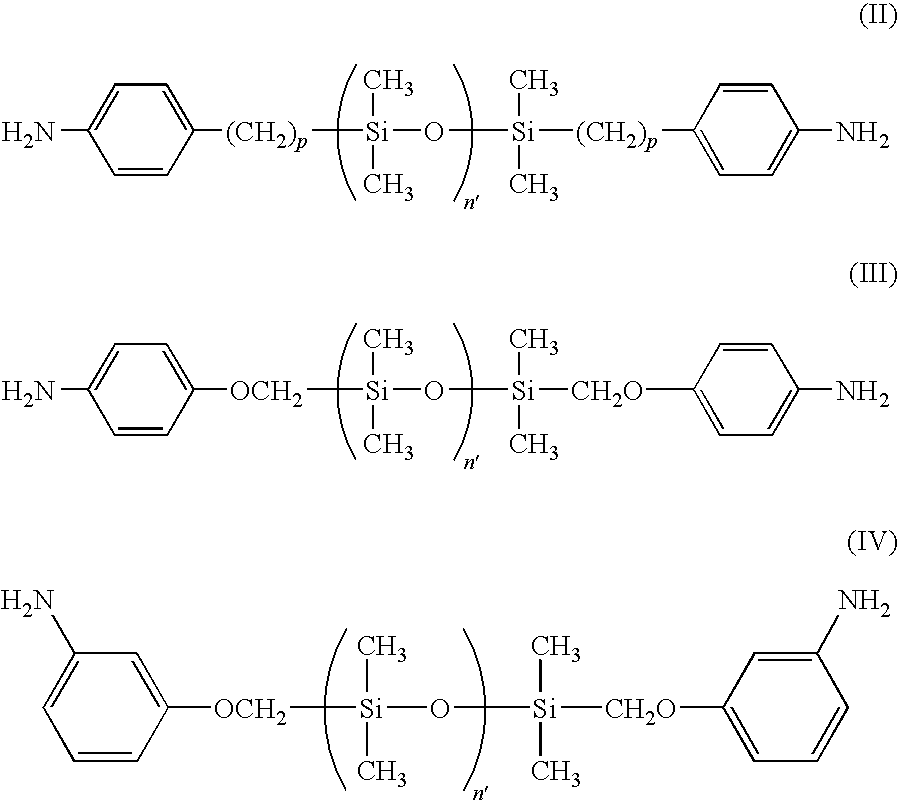Photosensitive Ink Composition for Screen Printing and Method of Forming Positive Relief Pattern with Use Thereof
- Summary
- Abstract
- Description
- Claims
- Application Information
AI Technical Summary
Benefits of technology
Problems solved by technology
Method used
Image
Examples
synthesis example 1
[0074]To a three-necked separable flask equipped with a stainless steel anchor agitator, and a condenser comprising a trap for water separation and a cooling tube having balls are attached. Bis-(3,4-dicarboxyphenyl)etherdiacid dianhydride (hereinafter referred to as “OPDA” for short) in an amount of 93.07 g (300 millimoles), 136.80 g (150 millimoles) of diaminosiloxane compound BY16-853U (amino equivalent: 456) produced by Dow Corning Toray, 14.02 g (50 millimoles) of 3,3′-diamino-4,4′-dihydroxydiphenylsulfone (hereinafter referred to as “ABPS” for short), 4.00 g (40 millimoles) of γ-valerolactone, 6.33 g (80 millimoles) of pyridine, 259 g of γ-butyrolactone, 173 g of methyl benzoate and 40 g of toluene are added.
[0075]After stirring the mixture at 180 rpm at room temperature under nitrogen atmosphere for 30 minutes, the mixture was heated to 180° C. and stirred for another 2 hours.
[0076]During the reaction, toluene-water azeotrope was removed.
[0077]After cooling the mixture to room...
synthesis example 2
[0078]A mixture of 62.04 g (200 millimoles) of ODPA, 160.00 g (100 millimoles) of X-22-161A (amino equivalent: 800), 3.00 g (30 millimoles) of γ-valerolactone, 4.75 g (60 millimoles) of pyridine, 301 g of γ-butyrolactone, 201 g of methyl benzoate and 60 g of toluene was stirred at 180 rpm at room temperature under nitrogen atmosphere for 30 minutes, and the mixture was heated to 180° C., followed by stirring the mixture for another 2 hours. During the reaction, toluene-water azeotrope was removed.
[0079]After cooling the mixture to room temperature, 31.02 g (100 millimoles) of ODPA, 24.83 g (100 millimoles) of 4,4′-diaminodiphenylsulfone (hereinafter referred to as “PDDS” for short), 28.03 g (100 millimoles) of ABPS, 112 g of γ-butyrolactone, 75 g of methyl benzoate and 40 g of toluene were added, and the resulting mixture was stirred at 180° C. at 180 rpm for 5 hours. The refluxed materials were removed to obtain a polyimide solution having a concentration of 30%. The molecular weig...
synthesis example 3
[0080]A mixture of 58.84 g (200 millimoles) of 3,3′,4,4′-biphenyltetracarboxylic dianhydride (hereinafter referred to as “BPDA” for short), 91.20 g (100 millimoles) of BY16-853U (amino equivalent: 456), 3.00 g (30.0 millimoles) of γ-valerolactone, 4.75 g (60 millimoles) of pyridine, 200 g of γ-butyrolactone, 133 g of methyl benzoate and 60 g of toluene are added. After stirring the mixture at 180 rpm at room temperature under nitrogen atmosphere for 30 minutes, the mixture was heated to 180° C., followed by stirring the mixture for another 2 hours. During the reaction, toluene-water azeotrope was removed.
[0081]After cooling the mixture to room temperature, 31.02 g (100 millimoles) of ODPA, 28.63 g (100 millimoles) of 3,3′-dicarboxy-4,4′-diaminodiphenylmethane (hereinafter referred to as “MBAA” for short), 29.23 g (100 millimoles) of APB, 119 g of γ-butyrolactone, 80 g of methyl benzoate and 60 g of toluene were added, and the resulting mixture was stirred at 180° C. at 180 rpm for 5...
PUM
| Property | Measurement | Unit |
|---|---|---|
| Temperature | aaaaa | aaaaa |
| Temperature | aaaaa | aaaaa |
| Percent by mass | aaaaa | aaaaa |
Abstract
Description
Claims
Application Information
 Login to view more
Login to view more - R&D Engineer
- R&D Manager
- IP Professional
- Industry Leading Data Capabilities
- Powerful AI technology
- Patent DNA Extraction
Browse by: Latest US Patents, China's latest patents, Technical Efficacy Thesaurus, Application Domain, Technology Topic.
© 2024 PatSnap. All rights reserved.Legal|Privacy policy|Modern Slavery Act Transparency Statement|Sitemap



